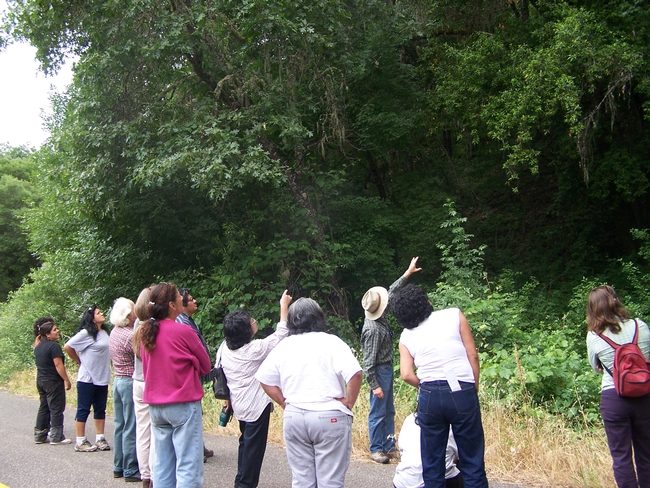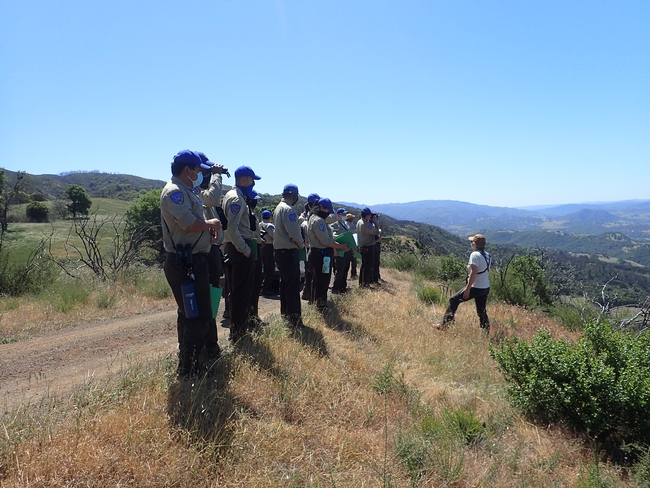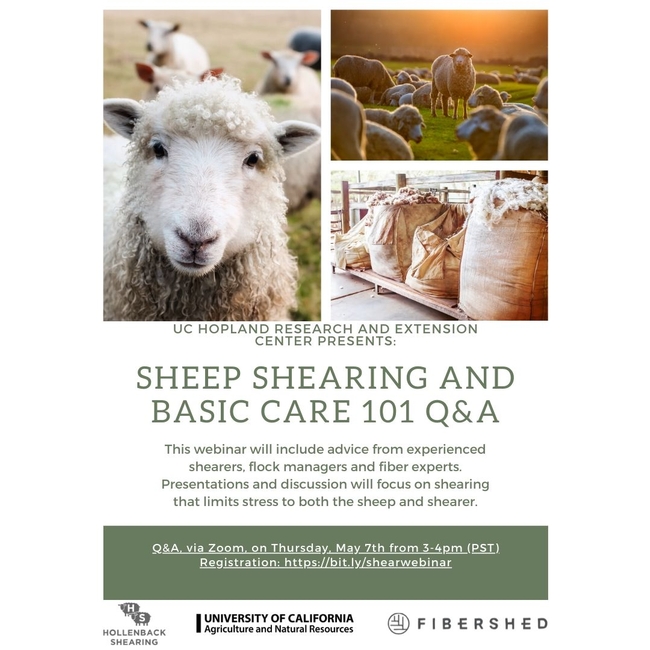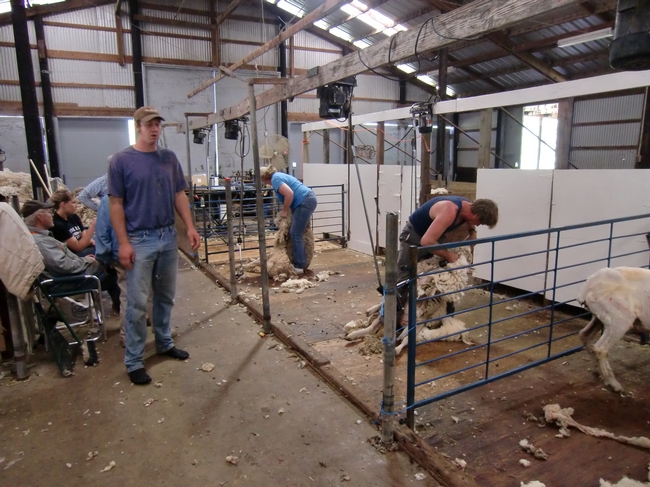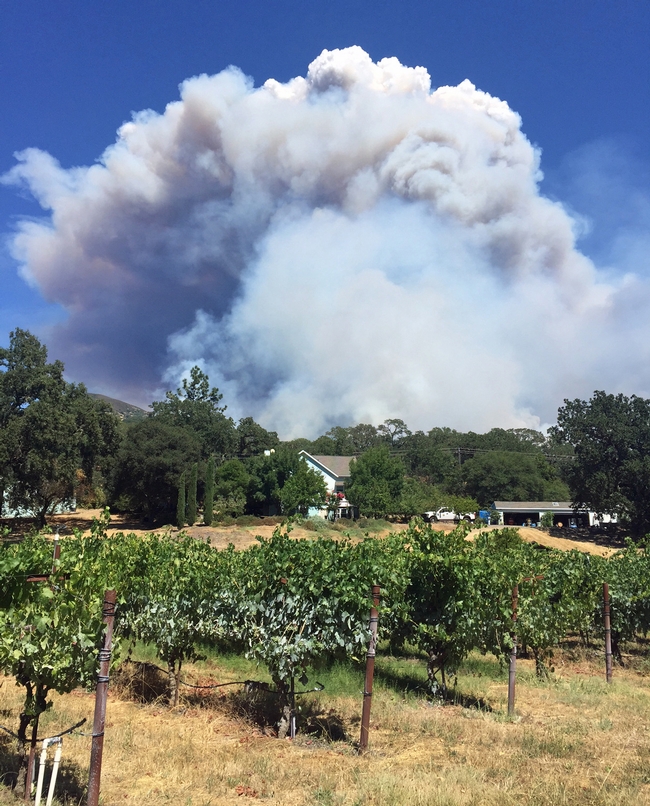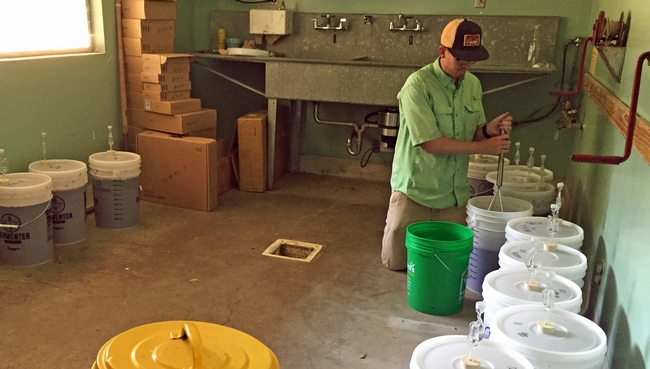
Posts Tagged: Hopland Research and Extension Center
Tribal Engagement at the Hopland Research and Extension Center
The Hopland Research and Extension Center is situated on the traditional, ancestral and unceded lands of the Shóqowa and Hopland People, whose historical and spiritual relationship with these lands continues to this day and beyond (for more on the Land and people history of the site, see this story map). It was, and continues to be, difficult for Indigenous people to thrive in the Shanél Valley after they were forced off the fertile land and had to resettle on relatively small upland parcels and away from freshwater sources. UC ANR staff and academics at the Hopland Research and Extension Center are working to build relationships with the Hopland Band of Pomo Indians who live and work next door at the Hopland and Nacomis Rancherias.
Hopland REC Director John Bailey is committed to building relationships with the intention of enabling maximum benefits for local tribal communities. Tribal Chairperson Sonny Elliot and the Council have been helping us find ways to collaborate after a long history of distrust and despite the University's founding using the sales of expropriated lands (Land-Grant College Act, 1862) and our continued occupation of California Indian territories. Bailey is working with local tribes to define a newly funded Academic Advisor position to build relationships, advance UC policy around working with Tribes, and restore good fire to the landscape with the help of cultural practitioners.
We have secured funding to hire a Native college student to help revitalize ecocultural wetlands in Hopland this summer. The intern will spend time talking with Indigenous people living within the oak woodland landscape or North Coast California and develop a plan for stewarding ecoculturally important sites at the Hopland Research and Extension Center with the Hopland Band of Pomo Indians and local experts in traditional ecological knowledge. This internship offers an opportunity for a Native American college student or two to learn about wetland systems and traditional ecological knowledge; and share their experience with other tribal community members.
Hunting opportunities for Tribal youth and their families and plant collection sites for basket materials are available. The hope is that more cultural ceremonies can take place where generations of Pomo people spent time near the waterways that span Hopland REC. Finally, together we are exploring ways to modify access of existing roads at Hopland REC to allow for potential emergency evacuation for Rancheria residents.
More to come, we hope.
New wave of California Naturalists emerge from course at Hopland REC
Thirty-eight young, budding naturalists sit in a meadow while journaling and sketching their observations of the wildflowers and birds around them. They have come from various educational backgrounds to gather at the University of California Agriculture and Natural Resources' Hopland Research and Extension Center (REC) to learn about local natural ecosystems through a California Naturalist course.
Although they vary in expertise, these students share a common motivation: immerse themselves in the natural world and eventually teach others about its importance.
“The class really changed the way I view the world around me,” said Will Zuniga, a recent class participant at Hopland REC. “Now that I've taken it, I don't just see plants around me – I see stories. I understand more about the relationship that all of nature's moving parts have with each other. The class has given me more drive to learn about the world around me and to teach others as well.”
Under the UC ANR umbrella, the California Naturalist Program certifies participants through an immersive 40+ hour class delivered by one of its partner organizations, in this case, the California Conservation Corps (CCC). Aged 18 to 25 (and U.S. military veterans up to age 29) and from diverse educational backgrounds across the state, these California Naturalist students worked hard to fulfill the mission of the CCC – to protect and enhance California's natural resources and communities through education and service.
The California Naturalist Program promotes environmental literacy and stewardship through discovery and action. The program is designed to introduce Californians to the wonders of our unique ecology, engage the public in the study and stewardship of California's natural communities, and increase community and ecosystem resilience. Many other states have similar naturalist programs, but this is the first statewide program in California.
“California Naturalist training allows people of different backgrounds to come together to set what is the standard for how we talk about the sky, the ground below us, and the water that's flowing around us,” reflected Jacob Croasdale, a former class participant. “[They teach us] how to engage respectfully in a way that allows us to both receive and give back to nature.”
Although students graduate with broad knowledge of California's natural wonders, prior knowledge of the course's subject matter is unnecessary. “At first, I thought…I don't belong here. I'm just this artist - what do I have to offer?” shared Monique Wales, another former class participant. “There were Master Gardeners, geologists, biologists and people with crazy amounts of knowledge. But we all came together with such enthusiasm, and we wanted to learn from each other. It was such a fun group.”
“People who are thinking about the California Naturalist program but aren't sure that they know enough to step into something where the language is maybe more technical than they're familiar with should not be intimidated,” added Pete Devine, resident naturalist at Yosemite Conservancy. “A lot of participants are beginners and just generally interested folks. These people belong in the California Naturalist Program.”
A quick peek at the syllabus reveals many themes, field trips and interactions with local experts that culminate in the well-rounded knowledge necessary to help preserve our unique ecosystems. California has an incredibly diverse range of wildlife, habitats, rivers, lakes and coastal resources – wild and urban alike – and ecosystem and community resilience are essential.
After the course is completed, California Naturalists perform service through education and interpretation, stewardship, participatory science, environmental program support, community resilience and environmental justice. To date, certified California Naturalists, together with Climate Stewards (another component of the program), have volunteered more than 250,000 hours, worth over $7 million, in 52 of 58 counties in California.
The relationship between CCC and California Naturalist was piloted at the Hopland REC over the last two years and is now being rolled out across the state with support from the Prop 64 Youth Community Access fund. Overall, the project aims to offer three California Naturalist instructor trainings for 48 youth leaders, 24 California Naturalist certification courses for 480 Corps members, visits to or engagement with over 40 unique cultural and natural resources around the state each year, and 3,840 hours of service-learning outreach through youth-led video capstone projects promoting natural and cultural resources.
Overall (and most importantly), the California Naturalist Program allows corps members to have a solid connection to the “why” of their hard work.
Perhaps if we can all connect a bit more with nature in our backyard, we too will see the stories hidden in the plants, water, animals and land.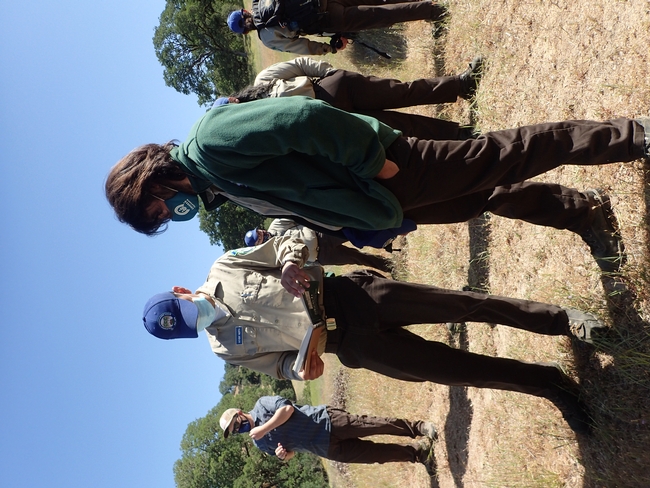
Webinar: Sheep shearing and basic care 101
The University of California Hopland Research and Extension Center (HREC) will offer a sheep shearing and basic care Q&A via Zoom from 3 to 4 p.m. May 7. The session will include advice from experienced shearers, flock managers and fiber experts.
Presentations and discussion will focus on shearing that limits stress to both the sheep and shearer. We also encourage your questions regarding sheep handling, husbandry, flock health, running a mobile shearing service, ethical shearing, grazing for fuel reduction and climate beneficial ranching practices. This webinar will take the place of the planned Sheep Shearing and Basic Care 101 immersive workshop planned at HREC in Spring 2020.
Participants in the webinar may also be interested in learning more about the class planned for 2021. Due to these unprecedented times, you do not have to have been registered for the Sheep Shearing 101 class to attend this Q&A session.
The session is free, but registration is required. Click here to register for the webinar and to share your questions.
Speakers:
Ruthie King
King is a shepherd focused on intensive rotational grazing for soil building, ecosystem restoration, fuel reduction and nutrient/water cycling. She raises Icelandic and Targhee sheep and sells meat, wool, and pelts through direct marketing. Services she offers include sheep shearing and contract grazing.
Alison Smith
Smith is the shepherd of the flock of over 200 sheep at the UC Hopland Research and Extension Center. She also supports research and extension at the site.
Trevor Hollenback
Owner/operator of Hollenback Shearing, Hollenback has been professionally trained and employed as a shearer in the United States, New Zealand, Australia, and Austria. His primary focus in shearing is limiting stress to both the sheep and shearer.
Rebecca Burgess
Burgess is the executive director of Fibershed, chair of the board for Carbon Cycle Institute, and the author of “Harvesting Color.” A vocationally trained weaver and natural dyer, she creates hands-on curricula that focus on restoration ecology and fiber systems. Burgess has built an extensive network of farmers and artisans in the Northern California Fibershed to pilot an innovative fiber systems model at the community scale.
Where there is fire, is there smoke flavor in winegrapes?
UPDATED: Viticultural area is Kelsey Bench, not Kelseyville Bench.
UC Cooperative Extension study shows smoke damage to grapes not uniform across vineyards
By the time the Mendocino Complex Fires were officially contained on Oct. 4, 2018, five weeks after igniting, they had burned approximately 450,000 acres in Colusa, Lake, Glenn and Mendocino counties, making it the largest wildfire in California history, according to CalFire.
The fire not only destroyed 280 homes and other buildings, its smoke destroyed the market for wine grapes grown in vineyards near burned areas.
Fearing grapes near the fire would impart smoke flavors to the wine, some wineries rejected all fruit from nearby regions of Lake County and Potter Valley, leaving grape growers to hastily find new destinations for their 2018 crop.
“It can be difficult to determine if fruit has been compromised in quality when exposed to wildfire smoke, and whether or not smoke flavors will result in wine when fermented,” said Glenn McGourty, UC Cooperative Extension advisor in Mendocino County.
A new UC Cooperative Extension study shows wind direction and speed, temperature and a vineyard's proximity to an active fire are factors that can help growers and winemakers predict smoke damage to fruit.
“Fruit in my own vineyard, 60 feet across the street from where the fire started, had no smoke damage because the wind was blowing away from it,” McGourty said.
$41 million hit to wine grape sales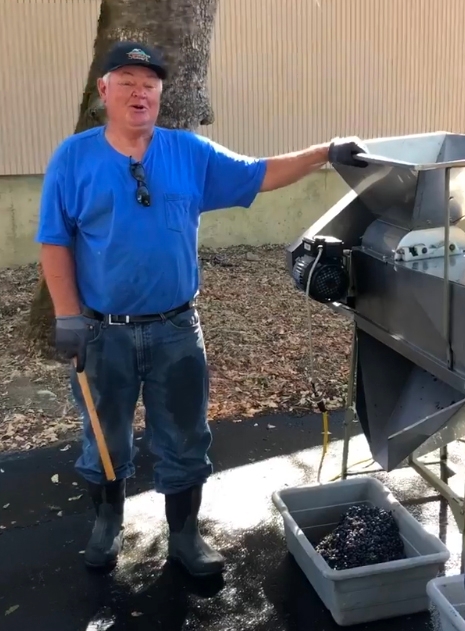
Due to the Mendocino Complex Fires, an estimated $41 million worth of winegrapes, which would have been sold at full price, were impacted – some were sold at a discount, some were sold to other customers, some were custom crushed, while some were left hanging in the vineyard, according to the Lake County Winegrape Commission and Mendocino County Farm Bureau.
The wine industry needed a scientific method of determining whether grapes could be made into a wine untainted by smoke. With funding from the Lake County Winegrape Commission, McGourty formed a workgroup of local growers and winemakers with Anita Olberholster, UC Cooperative Extension enology specialist in the Department of Viticulture & Enology at UC Davis, to research when fruit quality has been compromised.
“The need for industry standards regarding the impact of wildland smoke on winegrapes and the resulting wines has become even more pressing over the past few years,” said Debra Sommerfield, president of the Lake County Winegrape Commission.
Science showed the intensity, duration and timing of the exposure to wildfire smoke affects the grape's uptake. Generally, the closer to harvest, the greater risk to the fruit.
“Both the fruit and wine samples in our study showed a wide range of volatile phenol and glycocide concentrations, indicating that smoke damage to fruit was not uniform across the vineyards sampled,” McGourty said.
Volatile phenols and glycosides create off-flavors
Fresh smoke contains volatile phenols and glycosides that can affect fruit, but these chemicals tend to dissipate in the atmosphere in 1 to 2 hours. Vineyards close to actively burning fires and in the path of fresh smoke are most likely to be affected by smoke taint. Smoke that travels long distances is less likely to affect grapes and the wine made from the fruit.
The combination of volatile phenols and glycosides create “smoke taint” – both aromatic and tactile in the mouth. Wine drinkers may smell smoke or other off flavors and experience a drying of their mouth when high concentrations of the chemicals are present in wine.
“At lower concentrations, smoke taint reminds you of brett-affected wines,” Oberholster explained, referring to the yeast brettanomyces. “There is a shortness of fruit, a kind of dryness in the mouth that you know isn't normal. There may be barely perceptible aromas that aren't normal as well.”
Following wildfire smoke exposure, the researchers sampled fruit from 14 cabernet sauvignon vineyards around the viticultural areas of Lake County, including Upper Lake, High Valley, Big Valley, Kelsey Bench, Red Hills, Lower Lake and Guenoc Valley. As a control, fruit was also sampled from a Napa Valley vineyard that was not exposed to wildfire smoke.
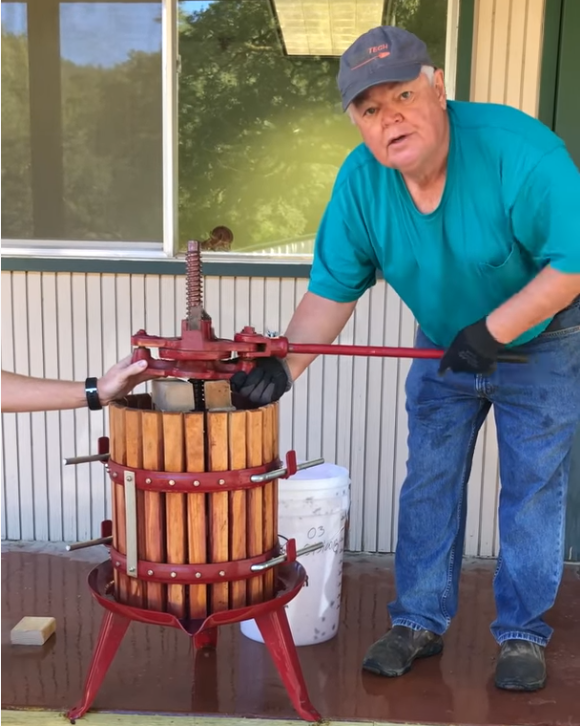
“The volatile phenols guaiacol and 4-methyl guaiacol are detected in the fruit by gas chromatography, so it is possible to sample fruit before harvest to make picking decisions,” McGourty said. “Based on our study, berry sampling and guaiacol/ 4-methyl guaiacol analysis are useful for a quick evaluation of whether or not fruit from a particular vineyard may have the presence of volatile phenols that can potentially result in smoke-affected wine.”
Testing the fruit for volatile phenols and glycosides is both expensive and not completely predictive as standards are not well defined for damage based on smoke chemical concentration, he cautioned.
These two compounds aren't the only ones that cause smoke flavors. More than 70 other compounds in forest fire smoke can also produce undesirable flavors and odors described as “like licking an ash tray, burnt garbage, a burnt potato, a campfire that has been drenched with water.”
The taste test
To assess the levels of the compounds that produce the off-flavors, Oberholster convened a panel of 14 wine industry professionals to taste the sample wines. The wine tasters detected stronger off-flavors in the wines made from riper fruit, which also contained higher concentration of smoke compounds. Less than 6 micrograms per liter of the smoke compounds were difficult for the tasters to detect, leading the researchers to conclude they will have a minimal effect on wine quality.
Smoke from a distant fire
The scientists also looked at the influence of distance from the fire and elevation on smoke taint. They found some vineyards close to the edge of fires and immediately downwind were heavily affected, with the grapes containing high concentrations of the smoke flavor-causing compounds. But they determined elevation was not a factor in smoke flavors in wines.
Wind direction and speed, temperature and vineyard proximity to active fires are highly likely affect whether there will be smoke damage to the fruit, their research showed.
“Smoke generated in the first one or two hours from a wildfire is most damaging to nearby vineyards,” McGourty said. “Even though a vineyard may be enveloped in smoke, if the source of the smoke is from a distant fire, it will probably won't seriously damage the fruit quality because most of the volatile gases are gone.”
Lake County Winegrape Commission's Sommerfield said, “Today, the results of this study are already proving to be useful in deepening our understanding of smoke and the risks it poses to grapes and wine, in enabling grape growers and winery buyers to engage in fruitful discussions and make informed decisions, and, in turn, in helping to propel the development of industry standards and protocols.”
To read more about the study by McGourty, Michael I. Jones, Oberholster and Ryan Keiffer, see the January 2020 edition of Wine Business Monthly at https://www.winebusiness.com/wbm.
“This is a great little study, the first one that I know of that takes a systems approach to evaluating the effects of wildfire smoke,” said McGourty.
Glenn McGourty, UCCE viticulture advisor for Mendocino County, describes for Hannah Bird the UC project to analyze the effect of wildfire smoke on winegrapes.
Introducing our Summer Camp Intern, Taylor Woodruff
Hi! I'm Taylor Woodruff, the new summer camp intern for the Sustainable You! - Adventure Science Camp! I am 21 years old, graduated from Clear Lake High School in 2015, and am currently a student at Mendocino College. At the college, I am a tutor for Statistics and Trigonometry. I am also Secretary of Gaming Club and an active member of Anime Club! I will be transferring soon with a degree in both Allied Health and Biology. I intend to pursue Marine Biology so I can study and help conserve sharks! I love all animals and plants. If there's any outdoor activity, count me in! I grew up playing soccer, volleyball, basketball, track, snowboarding, waterskiing and barefoot skiing. Fun fact: I have been classically trained to play the flute since 5th grade. I am kind, very easy to get along with, and determined to get any task done.
The UC Hopland Research and Extension Center is such a wonderful place. Everyone has been so warm and welcoming. I had little knowledge of the area before being recommended for this internship position, but I am so glad that I was selected. There is so much beautiful property out here -- 5,300 acres! Such a wonderful place for researchers to come out. Speaking of researcher, I've gotten to meet quite a few!
I stopped in and got to ask Dr. Vardo-Zalik and her team all about what they are doing with their lizard malaria research. Being a science major myself, I was super interested and wanted to bug them as much as I could. She explained a lot to me, let me hold and identify the genders of the Western Fence Lizards, observe a vector of the malaria parasite (the Sand Fly), watch them take blood samples, and I even got to look at those samples under the microscope through oil immersion. All of it was so fascinating. She also shared with me her passion for sharks and rays, and I think that was my favorite part. :)
I also got to meet some of the Brashares lab researchers. Talking to them was interesting as well, hearing about how they plan to catch a mountain lion and put a tracking collar on it. They are going to help out during our summer camp to have the kids set trail cameras, set small mammal traps, and check the traps in the morning. Hannah Bird even showed me a lot of the pictures that have been captured on different wildlife cameras scattered around the property. There are beautiful pictures of mountain lions, black bears, coyotes, raccoons and deer.
Thanks to Alison Smith letting me know when, I was able to see the two cutest baby lambs! While preparing for an insect activity down in the creek, I got distracted by all the tadpoles! There were so many and some had already developed teeny-tiny legs. Super cute. It's also pretty fun to take a moment and watch the woodpeckers. Brook Gamble was nice enough to give me California Naturalist journal as a present on my first day. Brook, Hannah and I got to use them and try out some of the journal activities we plan to do with the campers. I also got to share with Brook an awesome video I took of a spider making a web. It might get posted on the California Naturalist instagram, so be on the lookout! :)
In order to view more of the property and get away from the computer for a bit, I was able to help out our volunteer phenologists. We went around to multiple species of trees and other plants to record a lot of data including how many leaves, how many flowers, recording post-fire data, and more. They were very kind and funny. I'm glad I got to help them out.
Planning camp has been a lot of work! Staying organized and keeping on top of my tasks has prevented me from unwanted stress. This has been a lot of fun, but I am much more excited to meet the campers and run activities with them! Thank you Hannah, for everything!
--Taylor Woodruff

